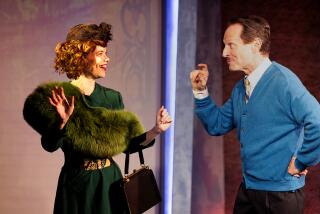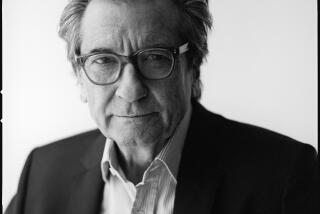Getting a bit burned ‘Under the Tuscan Sun’
- Share via
In the film version of Frances Mayes’ restoration drama “Under the Tuscan Sun,” Diane Lane plays a version of the poet and professor also named Frances Mayes. Directed by Audrey Wells, who loosely based her screenplay on Mayes’ book, the movie traces how Lane’s Frances -- younger, thinner, blonder and now flying solo -- travels to Tuscany whereupon she instantly falls for a mysterious stranger with the headily romantic name of Bramasole.
Reader, she bought Bramasole. The mysterious stranger being a house, of course, a now very famous house the color of apricot, ringed with flowers and herbs and, following the fantastic success of Mayes’ original meditation on Tuscany, awash in a peculiar kind of celebrity. Since the book’s publication in 1996, Bramasole has also inspired two sequels, an audio CD, engagement calendars and a furniture collection featuring armoires, chairs, mirrors and nightstands on which to rest your copy of “Under the Tuscan Sun” before sinking into one of the 10 Mayes-approved beds. This is no humble home; this is a cottage industry built on armchair tourism and an apparently infinite craze for all things kitsch-Mediterranean.
When a book hooks into the public consciousness like “Under the Tuscan Sun,” a movie adaptation often seems like a marketing fait accompli, no matter how unsuited the subject to the screen. To read Mayes’ unlikely first bestseller and the story of how she and her companion (now husband) Ed Kleinschmidt embarked on a painstakingly slow restoration of a centuries-old Tuscan villa is to be underwhelmed by the story’s cinematic potential.
From Mayes’ description, Bramasole sounds like it was once a gorgeous ruin and like any old house was also something of a mystery, one that gave up its secrets slowly. It was only by erasing coats of whitewash and hacking away at weedy thickets that Mayes really discovered Bramasole and, as she repeats throughout the book, herself.
For Mayes, the restoration wasn’t just a matter of duplicitous Italian contractors, Polish laborers and nerve-shredding overruns (although it was all that too), it was a way of finding a deeper sense of self. Riffing on the French philosopher Gaston Bachelard and her own Southern childhood, she writes, “Where you are is who you are.... Never casual, the choice of place is the choice of something you crave.” A little of this Marie Antoinette dithering goes a long way (let them eat cake -- on Murano glass!), but for better or worse, at least in her first book Mayes tends to write more about her kitchen, her garden and her cooking more than her philosophy. Still, it must have driven Wells mad trying to construct a screenplay out of so much plaster dust and self-absorption.
The strain shows. Lurching and frantic and over-broad, Wells’ movie succeeds neither on base commercial terms nor as a work of personal vision. That’s too bad not only because it features some appealing performers, but also because of the promise Wells showed a few years back with “Guinevere.” A spiky, tough-minded film about an affair between a young woman and a much older man, Wells’ directorial debut was as honest about female desire and all the messy contradictions that come with love and sex as her new movie is dishonest. The disparity between the features might be because the first was independently produced, but even Wells’ giddy screenplay for the studio hit “George of the Jungle” plays more real than this film.
The canniness of “Under the Tuscan Sun” is that Mayes makes the very privileged act of buying a second home in an expensive region in Italy a perfectly natural and attainable dream. The memoir is a solipsistic snooze, but it sells its entitled worldview with masterful ease. Wells, in contrast, is either uncomfortable with Mayes’ assumptions or just doesn’t understand how the writer hooked her readers; whatever the case, the screen Frances bears little relationship to the one who found herself in the book. Where Mayes is cool and somewhat aloof, albeit given to pitching an occasional fit when things don’t go her way, Lane is hot and bothered, aquiver with anxiety. Mayes does a lot of grunt work on Bramasole, but unlike Lane, the writer never lets you see her sweat.
The crucial difference between these visions of Frances is that while Mayes fell for a house, Lane’s character falls far harder for a stud named Marcello (Raoul Bova). That’s to be expected, mostly because a movie-length version of This Old Villa would likely be a raging bore and there’s no escaping that Lane cranks up the heat in her movies, even the ones in which she has to pretend she’s not a knockout. But the romance is a drag. It’s one thing that Frances’ object of desire is a young hunk rather than an old heap, as was the case with the book -- sure, let her have her fun in the hot Tuscan sun. The problem is one of bad faith: The movie pretends it’s peddling a vision of “you-go-girl” independence in which it doesn’t remotely believe.
Mayes found a new sense of self by tearing down walls and writing a memoir, but here all Frances does is radiate desperation. She cooks for the laborers, cares for a pregnant friend (Sandra Oh) and plays clucking mother hen to a couple of teenagers in hormonal overdrive. It’s a pleasure to watch Lane’s delicately lived-in face tremble with feeling -- it’s the truest thing in the movie -- but the character’s desperation feels wrong, the worst kind of sellout. After all the scrambling, the cooking and the nurturing, this Frances may possess a home and something of a community but not a self. The reason becomes clear as soon as Prince Charming drops by -- as far as the movie is concerned, it wasn’t just Bramasole that needed a handyman.
*
‘Under the Tuscan Sun’
*
MPAA rating: PG-13, for sexual content and language.
Times guidelines: Partial nudity, discreet sex, adult language.
Diane Lane...Frances
Sandra Oh...Patti
Lindsay Duncan...Katherine
Raoul Bova...Marcello
Vincent Riotta...Martini
Touchstone Pictures presents a Timnick Films Production, a Blue Gardenia Production, released by Touchstone Pictures. Director Audrey Wells. Screen story and screenplay by Audrey Wells. Based on the Frances Mayes book. Producers Tom Sternberg, Audrey Wells. Director of photography Geoffrey Simpson. Production designer Stephen McCabe. Editors Andrew Marcus, Arthur Coburn. Costume designer Nicoletta Ercole. Music Christophe Beck. U.S. casting Linda Lowy, John Brace. Italian casting Beatrice Kruger. In English and Italian with English subtitles. Running time: 1 hour, 53 minutes.
In general release.
More to Read
Sign up for our Book Club newsletter
Get the latest news, events and more from the Los Angeles Times Book Club, and help us get L.A. reading and talking.
You may occasionally receive promotional content from the Los Angeles Times.







